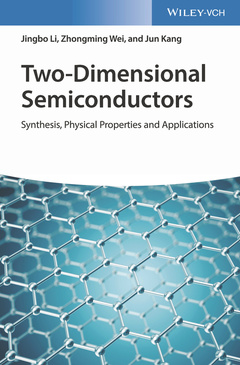Two-Dimensional Semiconductors Synthesis, Physical Properties and Applications
Auteurs : Li Jingbo, Wei Zhongming, Kang Jun

Two-dimensional (2D) materials have attracted enormous attention due to their exotic properties deriving from their ultrathin dimensions. 2D materials, such as graphene, transition metal dichalcogenides, transition metal oxides, black phosphorus and boron nitride, exhibit versatile optical, electronic, catalytic and mechanical properties, thus can be used in a wide range of applications, including electronics, optoelectronics and optical applications.
Two-Dimensional Semiconductors: Synthesis, Physical Properties and Applications provides an in-depth view of 2D semiconductors from theoretical studies, properties to applications, taking into account the current state of research and development. It introduces various preparation methods and describes in detail the physical properties of 2D semiconductors including 2D alloys and heterostructures. The covered applications include, but are not limited to, field-effect transistors, spintronics, solar cells, photodetectors, light-emitting diode, sensors and bioelectronics.
* Highly topical: 2D materials are a rapidly advancing field that attracts increasing attention
* Concise overview: covers theoretical studies, preparation methods, physical properties, potential applications, the challenges and opportunities
* Application oriented: focuses on 2D semiconductors that can be used in various applications such as field-effect transistors, solar cells, sensors and bioelectronics
* Highly relevant: newcomers as well as experienced researchers in the field of 2D materials will benefit from this book
Two-Dimensional Semiconductors: Synthesis, Physical Properties and Applications is written for materials scientists, semiconductor and solid state physicists, electrical engineers, and readers working in the semiconductor industry.
About the Authors xiii
Acknowledgments xv
1 Introduction 1
1.1 Background 1
1.2 Types of 2D Materials 4
1.3 Perspective of 2D Materials 6
References 7
2 Electronic Structure of 2D Semiconducting Atomic Crystals 9
2.1 Theoretical Methods for Study of 2D Semiconductors 9
2.1.1 Density Functional Theory 9
2.1.2 Linear Scaling Three-Dimensional Fragment (LS3DF)Method 10
2.1.3 GW Approximation 10
2.1.4 Semiempirical Tight-Binding Method 10
2.1.5 Nonequilibrium Green’s Function Method 11
2.2 Electronic Structure of 2D Semiconductors 11
2.2.1 Graphyne Family Members 11
2.2.2 Nitrogenated Holey Graphene 14
2.2.3 Transition Metal Dichalcogenides 15
2.3 Prediction of Novel Properties in 2D Moiré Heterostructures 19
2.3.1 MoS2/MoSe2 Moiré Structure 19
2.3.2 Graphene/Nitrogenated Holey Graphene Moiré Structure 26
2.3.2.1 Atomic Structure: Ordered Stacking Versus Moiré Pattern 26
2.3.2.2 Renormalized Fermi Velocity 31
References 33
3 Tuning the Electronic Properties of 2D Materials by Size Control, Strain Engineering, and Electric Field Modulation 35
3.1 Size Control 35
3.2 Strain Engineering 40
3.3 Electric Field Modulation 48
References 52
4 Transport Properties of Two-Dimensional Materials: Theoretical Studies 55
4.1 Symmetry-Dependent Spin Transport Properties of Graphene-like Nanoribbons 55
4.1.1 Graphene Nanoribbons 55
4.1.2 Graphyne Nanoribbon 57
4.1.3 Silicene Nanoribbons 59
4.2 Charge Transport Properties of Two-Dimensional Materials 61
4.2.1 Phonon Scattering Mechanism in Transport Properties of Graphene 61
4.2.2 Phonon Scattering Mechanism in Transport Properties of Transition Metal Dichalcogenides 63
4.2.3 Anisotropic Transport Properties of 2D Group-VA Semiconductors 67
4.3 Contacts Between 2D Semiconductors and Metal Electrodes 69
4.3.1 Carrier Schottky Barriers at the Interfaces Between 2D Semiconductors and Metal Electrodes 69
4.3.2 Partial Fermi Level Pinning and Tunability of Schottky Barrier at 2D Semiconductor–Metal Interfaces 70
4.3.3 Role of Defects in Enhanced Fermi Level Pinning in 2D Semiconductor/Metal Contacts 72
References 75
5 Preparation and Properties of 2D Semiconductors 79
5.1 Preparation Methods 79
5.1.1 Mechanical Exfoliation 79
5.1.2 Liquid-Phase Exfoliation 81
5.1.3 Vapor-Phase Deposition Techniques 85
5.2 Characterizations of 2D Semiconductors 90
5.2.1 Surface Morphology (SEM, OM, and TEM) 90
5.2.2 Thickness (Raman, AFM, and HRTEM) 92
5.2.3 Phase Structure (HRTEM and STEM) 93
5.2.4 Band Structure (Optical Absorption and Photoluminescence, ARPES) 94
5.2.5 Chemical Composition and Chemical States (XPS and EDS) 94
5.3 Electrochemical Properties of 2D Semiconductors 96
References 97
6 Properties of 2D Alloying and Doping 99
6.1 Introduction 99
6.2 Advantages of 2D Alloys 99
6.2.1 Adjustable Bandgap 100
6.2.2 Carrier-Type Modulation 103
6.2.3 Phase Change 104
6.2.4 Application of 2D Semiconductor Alloys in the Field of Magnetism 107
6.2.5 Improve Device Performance 108
6.3 Preparation Methods for 2D Alloys 110
6.3.1 Chemical Vapor Transport (CVT) 110
6.3.2 Physical Vapor Deposition (PVD) 111
6.3.3 Chemical Vapor Deposition (CVD) 113
6.4 Characterizations of 2D Alloys 114
6.4.1 STEM 115
6.4.2 Raman Spectroscopy 115
6.4.3 Photoluminescence (PL) Spectrum 119
6.5 Doping of 2D Semiconductors 119
References 121
7 Properties of 2D Heterostructures 123
7.1 Conception and Categories of 2D Heterostructures 123
7.2 Advantages and Application of 2D Heterostructures 125
7.3 Preparation Methods for 2D Heterostructures 129
7.3.1 Mechanical Transfer: Liquid Method and Dry Method 130
7.3.2 Chemical Methods 131
7.4 Characterizations of 2D Heterostructures 137
References 139
8 Application in (Opto) Electronics 143
8.1 Field-Effect Transistors 143
8.2 Infrared Photodetectors 145
8.2.1 Figures of Merit 146
8.2.2 Photodetection Mechanism 147
8.2.2.1 Photothermoelectric Effect 147
8.2.2.2 Bolometric Effect 147
8.2.2.3 Photogating Effect 148
8.2.2.4 Photovoltaic Effect 148
8.2.2.5 Plasmonic Effect 148
8.2.3 Typical 2D-Based Infrared Photodetectors 149
8.2.3.1 Graphene Infrared Photodetectors 149
8.3 2D Photodetectors with Sensitizers 151
8.3.1 Graphene-based Hybrids Detectors 151
8.3.2 TMD-Based Hybrid Detectors 152
8.3.3 Plasmonic Sensitized Detectors 153
8.4 New Infrared Photodetectors with Narrow Bandgap 2D Semiconductors 155
8.5 Future Outlook 156
8.5.1 Optoelectronic Memory of 2D Semiconductors 156
8.5.2 Solar Cells 161
References 162
9 Perspective and Outlook 165
Index 167
Jingbo Li, South China Normal University, Guangzhou, China
Zhongming Wei, Institute of Semiconductors, Chinese Academy of Sciences, Beijing, China
Jun Kang, Beijing Computational Science Research Center, Beijing, China
Date de parution : 04-2020
Ouvrage de 192 p.
17.5x24.9 cm
Disponible chez l'éditeur (délai d'approvisionnement : 14 jours).
Prix indicatif 118,16 €
Ajouter au panier


